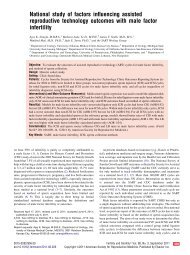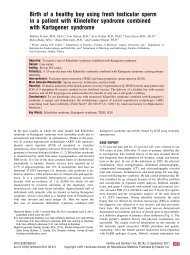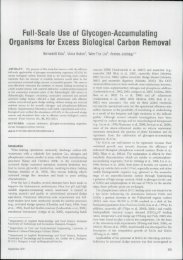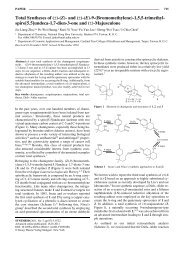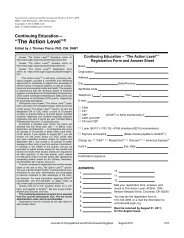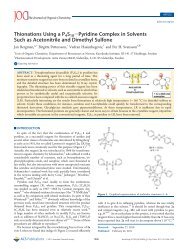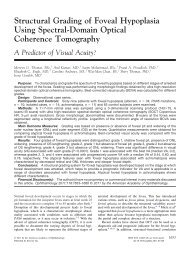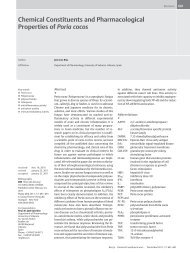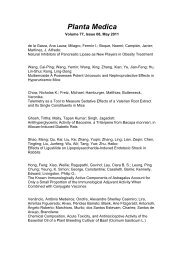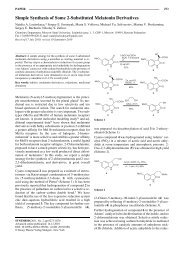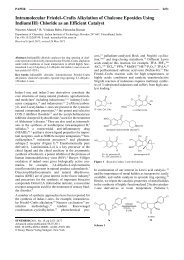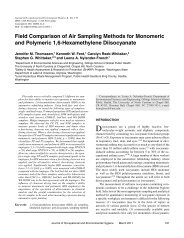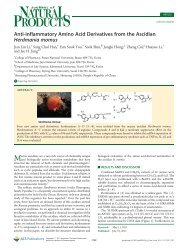Effects of Herbal Supplements on Drug Glucuronidation. Review of ...
Effects of Herbal Supplements on Drug Glucuronidation. Review of ...
Effects of Herbal Supplements on Drug Glucuronidation. Review of ...
You also want an ePaper? Increase the reach of your titles
YUMPU automatically turns print PDFs into web optimized ePapers that Google loves.
312<br />
<strong>Review</strong>s<br />
Table 1 Top selling herbal supplements in the United States and Europe.<br />
Source: NBJʼs Supplement Business Report, October 2007 [2] and IMS Health<br />
2009 (http://www.imshealth.com).<br />
US Europe<br />
Top herbs Sales<br />
($ milli<strong>on</strong>s)<br />
Top herbs Sales<br />
1 N<strong>on</strong>i juice 257 Ginkgo biloba 300<br />
2 Garlic 155 Saw palmetto 114<br />
3 Mangosteen juice 147 Valerian 61<br />
4 Green tea 144 English ivy 54<br />
5 Saw<br />
palmetto<br />
134 Pelarg<strong>on</strong>ium<br />
sidoides<br />
6 Echinacea 129 Psyllium 50<br />
7 Ginkgo biloba 106 Diosmin 45<br />
8 Ginseng 98 Grape seed 43<br />
9 Milk thistle 93 Myrtol 43<br />
10 Psyllium 85 Echinacea 40<br />
11 Soy 69 Milk thistle 40<br />
12 Cranberry 68 St. Johnʼs wort 40<br />
13 Maca 66 Sennosides A & B 34<br />
14 Goji 65 Hawthorn 34<br />
15 Green foods 64 Cranberry 33<br />
16 St. Johnʼs wort 60<br />
17 Aloe 60<br />
18 Stevia 58<br />
19 Black cohosh 57<br />
20 Valerian 55<br />
($ milli<strong>on</strong>s)<br />
als, are exempt from regulati<strong>on</strong>s applied to drugs, including premarketing<br />
safety and efficacy studies [11]. C<strong>on</strong>currently, the Internet<br />
became widely accessible and was comm<strong>on</strong>ly used to market<br />
herbal products, which led to an increase in the use <str<strong>on</strong>g>of</str<strong>on</strong>g> herbal<br />
supplements in the mid to late 1990s [12]. In 1998, the C<strong>on</strong>gress<br />
established the Nati<strong>on</strong>al Center for Complementary and Alternative<br />
Medicine (NCCAM) with the goal <str<strong>on</strong>g>of</str<strong>on</strong>g> funding research <strong>on</strong> the<br />
safety and efficacy <str<strong>on</strong>g>of</str<strong>on</strong>g> complementary and alternative medicine,<br />
including herbal supplements (nccam.nih.gov). Two years later,<br />
a milest<strong>on</strong>e case report published in The Lancet described an interacti<strong>on</strong><br />
between St. Johnʼs wort, an herbal supplement comm<strong>on</strong>ly<br />
used for depressi<strong>on</strong>, with the immunosuppressant drug<br />
cyclosporine [13]. This case report sparked a wave <str<strong>on</strong>g>of</str<strong>on</strong>g> clinical, in<br />
vitro, and animal studies addressing St. Johnʼs wort interacti<strong>on</strong>s<br />
Mohamed M-E F, Frye RF. <str<strong>on</strong>g>Effects</str<strong>on</strong>g> <str<strong>on</strong>g>of</str<strong>on</strong>g> <str<strong>on</strong>g>Herbal</str<strong>on</strong>g> … Planta Med 2011; 77: 311–321<br />
52<br />
with drug metabolizing enzymes and transporters [14]. Meanwhile,<br />
reports emerged associating ephedra use with heart attacks;<br />
these reports eventually led to a ban in sales <str<strong>on</strong>g>of</str<strong>on</strong>g> over the<br />
counter ephedra-c<strong>on</strong>taining products in several countries including<br />
the US, Canada, Australia, and Germany (http://www.erowid.<br />
org; accessed May 2010). These events set <str<strong>on</strong>g>of</str<strong>on</strong>g>f an alarm that research<br />
was needed to characterize the safety <str<strong>on</strong>g>of</str<strong>on</strong>g> herbal supplements<br />
as well as their potential to interact with c<strong>on</strong>venti<strong>on</strong>al<br />
drugs.<br />
In general, regulati<strong>on</strong> <str<strong>on</strong>g>of</str<strong>on</strong>g> herbal products is greater in the European<br />
Uni<strong>on</strong> (EU) than in the US. A 2004 EU directive mandates<br />
manufacturers <str<strong>on</strong>g>of</str<strong>on</strong>g> herbal products to register and license their<br />
products by the European Agency prior to marketing. In additi<strong>on</strong>,<br />
it mandates premarketing safety evaluati<strong>on</strong>s as well as postmarketing<br />
surveillance for serious adverse events [1]. In the US, the<br />
scientific community has recently requested that the FDA play a<br />
more rigorous role in evaluating safety and efficacy <str<strong>on</strong>g>of</str<strong>on</strong>g> herbal supplements<br />
with calls for premarketing safety data and studies <strong>on</strong><br />
interacti<strong>on</strong>s with drug metabolizing enzymes [15].<br />
Several case studies, reports, and review articles have described<br />
the potential <str<strong>on</strong>g>of</str<strong>on</strong>g> herbal supplements and phytochemicals to modulate<br />
cytochrome P450 (CYP) enzymes. C<strong>on</strong>versely, the effect <str<strong>on</strong>g>of</str<strong>on</strong>g><br />
herbal extracts <strong>on</strong> glucur<strong>on</strong>idati<strong>on</strong>, a major c<strong>on</strong>jugative metabolism<br />
pathway, has not been sufficiently studied. The aim <str<strong>on</strong>g>of</str<strong>on</strong>g> this<br />
review is to summarize evidence regarding the potential <str<strong>on</strong>g>of</str<strong>on</strong>g> the<br />
top-selling herbal supplements in the US and Europe to interact<br />
with UGT enzymes.<br />
Potential for Herb-<strong>Drug</strong> Interacti<strong>on</strong>s<br />
through <strong>Drug</strong> Metabolizing Enzymes<br />
!<br />
Enzymatic biotransformati<strong>on</strong> (i.e., metabolism) plays a major role<br />
in the dispositi<strong>on</strong> <str<strong>on</strong>g>of</str<strong>on</strong>g> endogenous and exogenous compounds including<br />
both drugs and herbal c<strong>on</strong>stituents. Biotransformati<strong>on</strong><br />
reacti<strong>on</strong>s are generally divided into phase I and phase II reacti<strong>on</strong>s,<br />
each <str<strong>on</strong>g>of</str<strong>on</strong>g> them encompassing a wide range <str<strong>on</strong>g>of</str<strong>on</strong>g> enzymes and<br />
catalytic activities [16]. Phase I reacti<strong>on</strong>s involve hydrolysis, reducti<strong>on</strong>,<br />
and oxidati<strong>on</strong> and usually result in <strong>on</strong>ly a small increase<br />
in hydrophilicity [17]. In phase I, CYP enzymes rank first in terms<br />
<str<strong>on</strong>g>of</str<strong>on</strong>g> clinical importance and number <str<strong>on</strong>g>of</str<strong>on</strong>g> substrates. On the other<br />
hand, phase II reacti<strong>on</strong>s include c<strong>on</strong>jugati<strong>on</strong> <str<strong>on</strong>g>of</str<strong>on</strong>g> compounds with<br />
Fig. 1 Timeline for milest<strong>on</strong>e events that have increased<br />
interest in studying herb-drug interacti<strong>on</strong>s.<br />
Abbreviati<strong>on</strong>s: DSHEA, Dietary Supplement Health<br />
and Educati<strong>on</strong> Act; HS, <str<strong>on</strong>g>Herbal</str<strong>on</strong>g> <str<strong>on</strong>g>Supplements</str<strong>on</strong>g>;<br />
NCCAM, the Nati<strong>on</strong>al Center for Complementary<br />
and Alternative Medicine; FDA, the Food and <strong>Drug</strong><br />
Administrati<strong>on</strong>.



